Abbreviation Cep Bayer/Flamsteed designation 43 Stars with planets 1 | Genitive Cephei Main stars 7 Messier object 0 | |
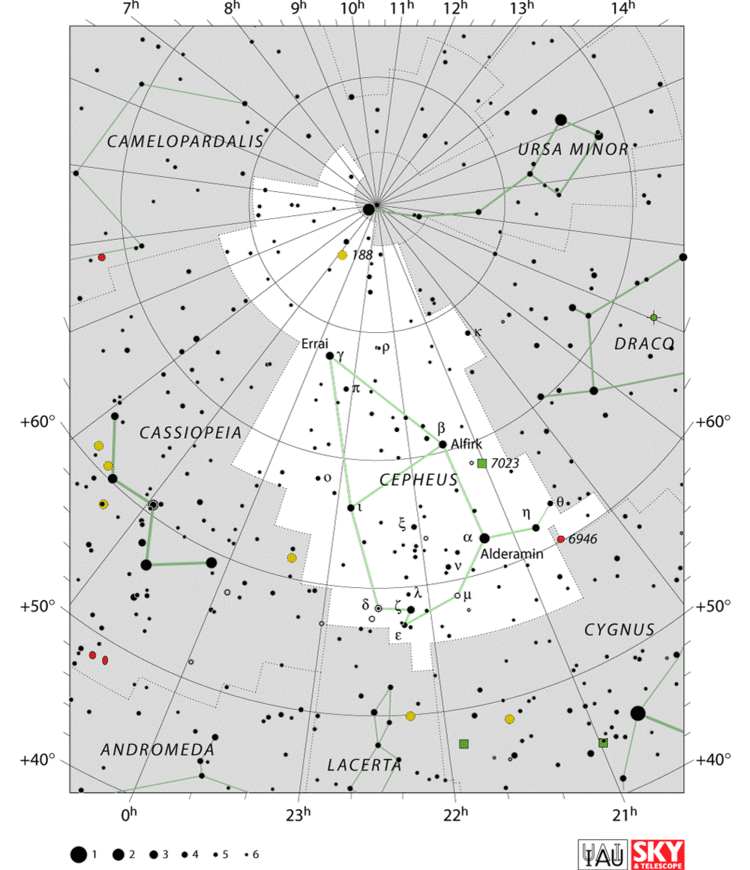 | ||
Pronunciation /ˈsiːfiəs/ or /ˈsiːfjuːs/;genitive /ˈsiːfiaɪ/ Right ascension 20 01 56.4481–09 03 19.7931 Declination 88.6638870°–53.3532715° Similar | ||
Cepheus is a constellation in the northern sky. It is named after Cepheus, King of Aethiopia in Greek mythology. It was one of the 48 constellations listed by the 2nd century astronomer Ptolemy, and remains one of the 88 modern constellations. Its brightest star is Alpha Cephei with an apparent magnitude of 3.5. Delta Cephei is the prototype of an important class of star known as a Cepheid variable. RW Cephei, an orange hypergiant, together with the red supergiants Mu Cephei, VV Cephei and V354 Cephei are among the largest stars known. In addition, Cepheus also has the hyperluminous quasar S5 0014+81, hosting an ultramassive black hole in its core at 40 billion solar masses, about 10,000 times more massive than the central black hole of the Milky Way, making it the most massive black hole known in the universe.
Contents
- History and mythology
- Features
- Deep sky objects
- Visualizations
- Equivalents
- In popular culture
- Namesakes
- References

History and mythology
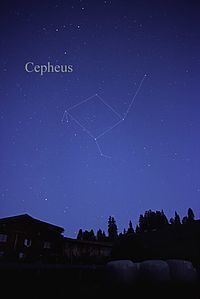
Cepheus was the King of Aethiopia. He was married to Cassiopeia and was the father of Andromeda, both of whom are immortalized as modern day constellations along with Cepheus.
Features
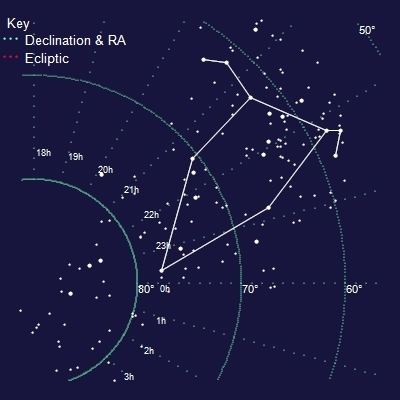
Delta Cephei is the prototype Cepheid variable, a yellow-hued supergiant star 980 light-years from Earth. It was discovered to be variable by John Goodricke in 1784. It varies between 3.5m and 4.4m over a period of 5 days and 9 hours. The Cepheids are a class of pulsating variable stars; Delta Cephei has a minimum size of 40 solar diameters and a maximum size of 46 solar diameters. It is also a double star; the yellow star also has a wide-set blue-hued companion of magnitude 6.3.
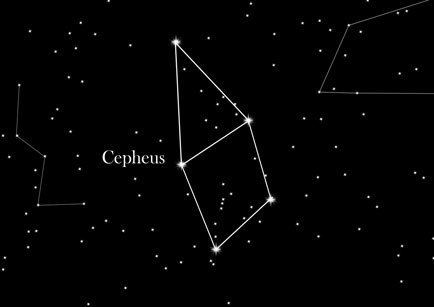
There are several other prominent variable stars in Cepheus. One, μ Cephei, is also known as Herschel's Garnet Star due to its deep red colour. It is a semiregular variable star with a minimum magnitude of 5.1 and a maximum magnitude of 3.4. Its period is approximately 2 years. The star is around 11.8 AU in radius. If it were placed at the center of the Solar System, it would extend to the orbit of Saturn. Another, VV Cephei A, like Mu Cephei, is a red supergiant and a semiregular variable star, located at least 5,000 light-years from Earth. It has a minimum magnitude of 5.4 and a maximum magnitude of 4.8. One of the largest stars in the galaxy, it has a diameter of 1,300 solar diameters. VV Cephei is also an unusually long-period eclipsing binary, but the eclipses, which occur every 20.3 years, are too faint to be observed with the unaided eye. T Cephei, also a red giant, is a Mira variable with a minimum magnitude of 11.3 and a maximum magnitude of 5.2, 685 light-years from Earth. It has a period of 13 months and a diameter of 500 solar diameters.
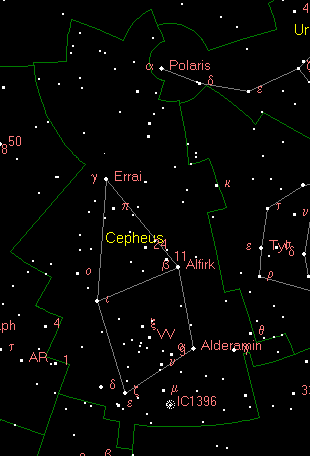
There are several prominent double stars and binary stars in Cepheus. Omicron Cephei is a binary star with a period of 800 years. The system, 211 light-years from Earth, consists of an orange-hued giant primary of magnitude 4.9 and a secondary of magnitude 7.1. Xi Cephei is another binary star, 102 light-years from Earth, with a period of 4000 years. It has a blue-white primary of magnitude 4.4 and a yellow secondary of magnitude 6.5.
Kruger 60 is an 11th magnitude binary star consisting of two red dwarfs. The star system is one of the nearest, being only 13 light years away from Earth.
Deep-sky objects
Visualizations
Cepheus is most commonly depicted as holding his arms aloft, praying for the gods to spare the life of Andromeda. He is also depicted as a more regal monarch sitting on his throne.
Equivalents
In Chinese astronomy, the stars of the constellation Cepheus are found in two areas: the Purple Forbidden enclosure (紫微垣, Zǐ Wēi Yuán) and the Black Tortoise of the North (北方玄武, Běi Fāng Xuán Wǔ).
